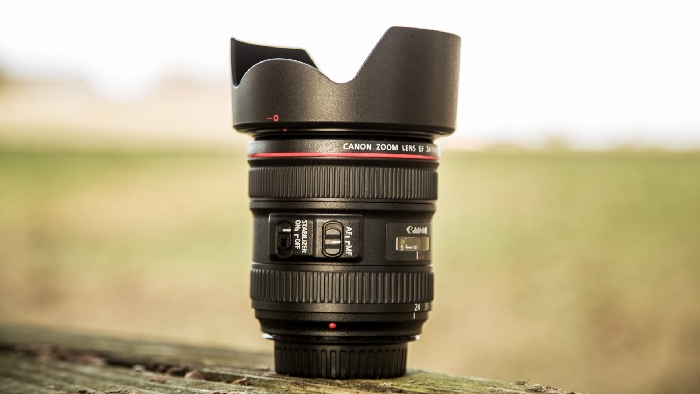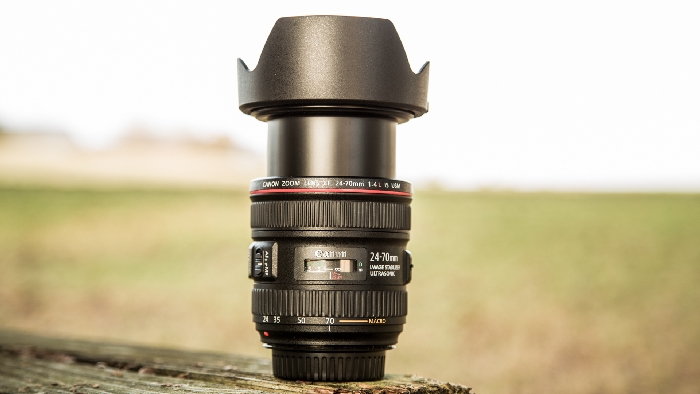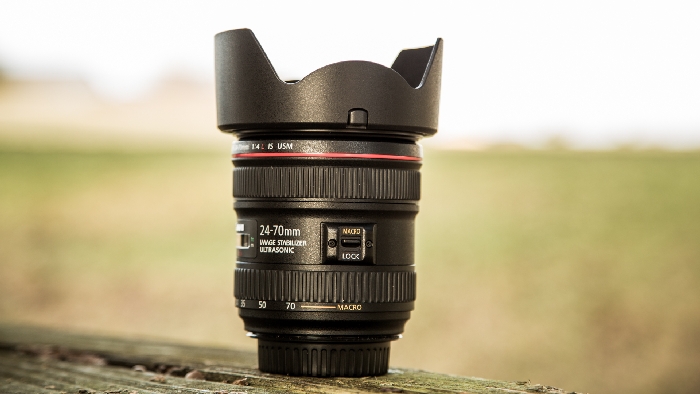Canon 24-70 f/4 IS Review - Updated w/Video
 This lens was a bit unexpected. While the 24-105mm f/4 IS needed an update due to its lackluster performance, the change to a 24-70mm focal length was not what was initially rumored though it is consistent with what Canon does with the 70-200mm series. Also part of this new upgrade was a hefty price upgrade, not so much from the retail price of the 24-105mm f/4 IS, but because the 24-105 can be found at greatly reduced prices due to the packaging of this as the kit lens in so many Canon cameras. Either way, this lens is now here and here to stay so let's take a look at the performance this has to offer. All shots were taken with the Canon 5D Mark III.
This lens was a bit unexpected. While the 24-105mm f/4 IS needed an update due to its lackluster performance, the change to a 24-70mm focal length was not what was initially rumored though it is consistent with what Canon does with the 70-200mm series. Also part of this new upgrade was a hefty price upgrade, not so much from the retail price of the 24-105mm f/4 IS, but because the 24-105 can be found at greatly reduced prices due to the packaging of this as the kit lens in so many Canon cameras. Either way, this lens is now here and here to stay so let's take a look at the performance this has to offer. All shots were taken with the Canon 5D Mark III.
Check for current Pricing
{youtube}
tlFTbI0Dt64
{/youtube}
See the Canon 24-105mm f/4 IS Vs Canon 24-70 f/4 IS
Build

This lens feels very similar to the older Canon 24-105mm f/4 IS however the new 24-70 f/4 IS is smaller and feels like a more portable alternative. The overall body feels secure and good in the hand although not quite up to the standards of many lenses in this price category. The focus ring feels loose for some reason and is very easy to turn. The zoom ring is fairly smooth though not spectacular and it is a little difficult to get to when attached to a camera body. The zoom ring is fairly narrow and very close to the base of the lens for those who use the zoom quite a bit. 
Thank you Canon for bringing out the new pinch lens caps which perform extremely well and allow easy removal with the hood on. Speaking of the hood, I had significant movement in the hood while attached to the lens. The hood could rock slightly and made noise when it did and made the lens feel like it was moving in my hands. Not good. The hood has a lock on it which needs to be pressed before it can be taken off. This will take some time to remember and I have not ever thought I needed it so i am not sure why it was added. I would prefer a more firmly fitting hood any day.
Sharpness
Sharpness has been an area that Canon has been improving on consistently with the new lenses they have been introducing, and thankfully, the Canon 24-70mm f/4 IS is a slight exception. Unfortunately, the widest we can shoot with this is f/4 and many lenses in this category look good at f/4. At 24mm, the Canon is seemly at its weakest point. It’s not that it is not sharp, but the differences between this and the older lens are less noticeable. What is noticeable however are the improvements in the corner sharpness and the reduction in chromatic abrasion. These reductions make the text look much better. At f/5.6 results are even better and are very sharp. At 50mm, the lens begins to undergo some greater improvements. The results were interestingly not as sharp at f/4 compared to the older Canon 24-105mm f/4 IS which was never knows as my sharp lens. Even stopping down to f/5.6 only improves the results slightly. The most notable difference between the older version and the new one is definitely corner sharpness. The old lens was horrible in so many ways once you looked into the corners and the new 24-70 behaves like any great zoom lens. Nothing earth shattering here but definitely an improvement. At 70mm the results did not appear to be quite as good as they were at 50mm, but were still very good. Text was clear and the increased contrast and decreased chromatic aberration from the previous lens help to make this lens a clear winner. At f/5.6 the results were even better and very sharp. Overall, i’d feel very comfortable shooting at f/4 at all focal lengths, even when sharpness is important although improvements were seen at all focal lengths when stopped down.
Test Image

24mm F/4 - 100% Crop

24mm F/5.6 - 100% Crop

50mm F/4 - 100% Crop

50mm F/5.6 - 100% Crop

70mm F/4 - 100% Crop

70mm F/5.6 - 100% Crop

Focusing
Unsurprisingly, this lens focused quickly and accurately in all of our tests. Results were better than the 24-105mm lens although the differences are hardly noticeable in most cases. My average focus times going from infinity to about 24 inches was less than .5 seconds which beat out my scores for the 24-105 by about a 10th of a second. With a high speed USM motor, I only expect great results from this Canon lens.
Bokeh Bokeh on this 24-70 f/4 IS rendered smooth circles and was definitely smoother and softer than the original Canon 24-105mm lens. With 9 aperture blades instead of the previous 8, this is to be expected. Of course the depth of field at 70mm is going to be greater than at 105mm so the new 24-70 at f/4 is probably not the best lens to use for rendering nice looking Bokeh and shallow depth of field.
Bokeh on this 24-70 f/4 IS rendered smooth circles and was definitely smoother and softer than the original Canon 24-105mm lens. With 9 aperture blades instead of the previous 8, this is to be expected. Of course the depth of field at 70mm is going to be greater than at 105mm so the new 24-70 at f/4 is probably not the best lens to use for rendering nice looking Bokeh and shallow depth of field.
Flare
Flare was not an issue with this 24-70mm f/4 IS. Flare was well controlled and difficult to see in my tests. Contrast was well controlled as well and the images looked right on compared to what I was seeing with my eyes. There did not seem to be any notable effects from shooting into the sun or placing the sun in a corner of the lens.
Vignetting  Considering that this is an f/4 lens, the results were not that great. Vignetting was visible in the corners at f/4 though a little less pronounced at f/5.6. However, results were vastly improved from the previous 24-105 which went to near black in the tips of the corners. Results here were fairly typical for decent zoom lenses though I wish it had slightly smoother fall-off. Either way software will get rid of this very quickly making it not a big area of concern.
Considering that this is an f/4 lens, the results were not that great. Vignetting was visible in the corners at f/4 though a little less pronounced at f/5.6. However, results were vastly improved from the previous 24-105 which went to near black in the tips of the corners. Results here were fairly typical for decent zoom lenses though I wish it had slightly smoother fall-off. Either way software will get rid of this very quickly making it not a big area of concern.
Macro
Ok, here is a way that this lens separates itself from all the competition. While in normal use, the Canon 24-70 f/4 IS exhibits about the same macro abilities as other 24-70 zooms, a small switch on the side allows for macro mode to be enabled and the lens will rotate into macro mode when the switch is unlocked. In this setting, .7x magnification is possible making this lens almost as good as a true macro lens. Considering the other lenses don’t come even close to this figure, the 24-70 f/4 IS is the clear winner. If you are considering purchasing a macro lens in the near future, this might be a decent alternative. This is a huge bonus for this lens and will cause many to take a second look at this lens when they would otherwise go elsewhere.
Conclusion The end result is that this is a great f/4 lens. It has stabilization which works extremely well, it is sharp, produces notably good results overall, and has the macro bonus. However, it is priced very high at the moment with a starting price of $1,500. This price is $200 higher than the Tamron 24-70 f/2.8 VC (comparison coming soon) which gives you an extra stop of light. This is a big advantage even when price is not an object. However, the Tamron does not include the macro abilities of the Canon 24-70 f/4 IS and it does mean using a 3rd party lens instead of the Canon. The fact is, if you don’t mind shooting at f/4, the Canon is the best lens around and brings plenty of improvements in sharpness, bokeh, and magnification. It is better than I expected and is a great all around lens, though with a hefty price tag. However, I can’t tell you how much I wish that this lens was f/2.8 lens and anyone who ever shoots indoors will probably share that dream with me. As a result, the Tamron will still be a compelling option for those looking for a 24-70 stabilized lens. The Canon 24-70mm f/4 IS should be the new kit lens with Canon’s higher end cameras and will bring welcome increases in sharpness to these new 20MP+ bodies.
The end result is that this is a great f/4 lens. It has stabilization which works extremely well, it is sharp, produces notably good results overall, and has the macro bonus. However, it is priced very high at the moment with a starting price of $1,500. This price is $200 higher than the Tamron 24-70 f/2.8 VC (comparison coming soon) which gives you an extra stop of light. This is a big advantage even when price is not an object. However, the Tamron does not include the macro abilities of the Canon 24-70 f/4 IS and it does mean using a 3rd party lens instead of the Canon. The fact is, if you don’t mind shooting at f/4, the Canon is the best lens around and brings plenty of improvements in sharpness, bokeh, and magnification. It is better than I expected and is a great all around lens, though with a hefty price tag. However, I can’t tell you how much I wish that this lens was f/2.8 lens and anyone who ever shoots indoors will probably share that dream with me. As a result, the Tamron will still be a compelling option for those looking for a 24-70 stabilized lens. The Canon 24-70mm f/4 IS should be the new kit lens with Canon’s higher end cameras and will bring welcome increases in sharpness to these new 20MP+ bodies.
This lens is available now from:





